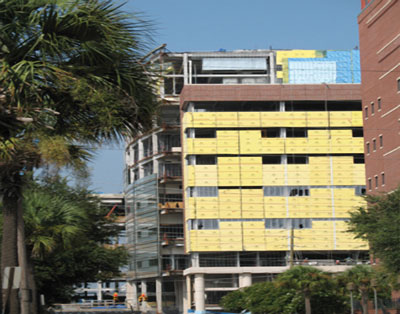EIFS Update: Pick the Right Substrate
Importance of the Substrate
Particularly important for the installation of EIFS, as it is for other wall types, is the choice of sheathing that forms the substrate upon which to build the EIFS. Common choices in the past have included plywood and paper faced exterior gypsum board. It didn't take long to realize that these choices had some distinct limitations and the potential for some severe problems.
First, the organic nature of wood and paper surfaces means that they are not particularly well suited to withstand weather exposure during construction. If they became wet, they would swell and cause deformities which telegraphed through the EIFS causing unwanted irregularities in the final surface. For the contractor to reduce the amount of weather exposure on the sheathing, the installation of the sheathing would need to be protected and then coordinated with the installation of the EIFS. This could mean delays in the construction process since the building might not otherwise be considered fully enclosed enough for other aspects of the work to occur. It would also mean the contractors would need to return afterwards to try to correct the defects caused by the weather exposure on the sheathing, often with limited real success.
Second, the presence of wood and paper provide one of the key ingredients for mold formation in walls: organic food. It is commonly understood that mold requires this organic material to feed on in addition to the presence of water and favorable temperature conditions. In the course of building design and construction it is problematic to completely eliminate moisture or even water in an assembly. Similarly, the range of temperatures that a wall assembly experiences in order to be favorable for human habitation is also favorable for mold growth. Hence, the only real tool to combat mold growth is the elimination of the organic material.
Third, the nature of both plywood and paper faced gypsum is that the outermost surface is laminated to interior surfaces within the substrate. Under normal conditions, the lamination process is appropriate and suitable to many applications. However, if moisture entered the space between the EIFS and the substrate, that lamination process was compromised and the outermost layer would sometimes separate (delaminate), causing the EIFS to literally come apart from the building it was applied to. This was clearly a problem and one that wasn't likely to be solved by trying to seal out all moisture in the wall.
 |
Figure 3: Paper free, fiberglass mat embedded gypsum sheathing panels being used as a substrate on the Medical University of South Carolina Ashley River Tower, Charleston, South Carolina Architect: NBBJ and LS3P Photo courtesy of Georgia-Pacific Gypsum |
Given these limitations and the significant problems with these organic substrates, a suitable alternative was sought and often required by regulators and EIFS manufacturers. Over the past decade, a number of sheathing manufacturers have looked for and developed alternatives. Currently, the most common choice is to specify engineered exterior gypsum sheathing. (See Figure 3.)
This type of sheathing typically contains a specially treated gypsum core with embedded fiberglass mats on both sides of that core. This process is referred to as glass mat bonding and means that there is no lamination that can become separated - the core and the surface are integral. And since mineral based fiberglass is used, the presence of organic materials is eliminated. The result is that this type of glass mat bonded sheathing provides superior moisture, fire and mold resistance. From a construction standpoint, it means that this type of sheathing and EIFS substrate can remain exposed to normal weather conditions for up to twelve months and still perform admirably.
An additional requirement imposed on the sheathing is the ability to act as a true drainage plane. In previous decades, EIFS installations were experiencing water problems, particularly in southern climates on residential applications, where water vapor resulting from high humidity conditions was entering and getting trapped between the insulation and the sheathing substrate. This caused the predictable problems of physical damage and deterioration along with the associated liability and business concerns. Once again regulators and manufacturers sought and found solutions. The current dominant approach is to use a vapor permeable air and moisture barrier, usually liquid applied. This barrier assembly protects sheathing from moisture intrusion and air leakage and allows the finished surface to act successfully as a true drainage plane. Hence, any moisture that does enter the wall assembly, either from inside or outside of the building, can drain down the surface of the sheathing. Of course, this means that there needs to be appropriate space for that drainage. In the case of EIFS, the simple act of installing the adhesive in vertical strips that are compressed to about 1/16- to 1/8-inch is adequate. Moisture can then drain down between these vertical strips to a starter strip or track at the base of the insulation, and weep out the bottom. Hence, even if moisture does find its way into the wall, it can now drain safely away without causing any damage. All of these advances and protections have come about because of the attention paid to using the appropriate substrate, coating it appropriately, and recognizing the importance of the surface where the EIFS meets the rest of the building.









